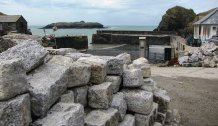Articles

Mullion Harbour in Cornwall is discussed in the book. Image courtesy of Caitlin DeSilvey.
‘Let some heritage sites go’, says academic
Some heritage sites cannot be preserved and should be allowed to decay, a new book argues.
In the future, climate change, falling budgets and other pressures will mean that some heritage sites cannot be protected, according to Professor Caitlin DeSilvey, author of Curated Decay.
If heritage has to be lost, she says, this should not always be viewed as a failure – but can involve a deliberate decision to allow nature to take its course and to learn from change.
“There is room to explore more creative approaches in how we care for heritage,” said Professor DeSilvey, of the Environment and Sustainability Institute on the University of Exeter’s Penryn Campus in Cornwall.
“What happens if we choose not to intervene? What possibilities emerge when change is embraced rather than resisted? What if we allow things to become ruins?
“Processes of decay and disintegration can be culturally – as well as ecologically – productive, but we also need to recognise that people have very strong feelings about these places, and those need to be considered as well.”
One of the sites featured in the book is the former atomic weapons testing facility at Orford Ness, Suffolk, which the National Trust manages through a policy of “continued ruination”.
“Orford Ness is an interesting case because it shows that we don’t always have to associate ruination with failure and neglect,” said Professor DeSilvey.
“Where the process of physical decay is going on, and nature is moving in, we can try to see this in a positive light and ask ourselves what we can learn from those changes.”
Another landmark discussed in the book is Mullion Harbour in Cornwall, where the National Trust has spent an average of £1,500 a week maintaining and protecting the harbour from increasingly powerful winter storms.
But despite its efforts, the Trust concedes that “a tipping point might be reached when it would be necessary to call a halt to repairs”.
Professor DeSilvey said: “One way to think about places like Mullion is to consider the how we could mark the ‘afterlife’ of the harbour by re-using its materials in other structures, and remembering its passing in that way.
“It’s hard to let go, and in this book I am asking how we can do this gracefully and attentively.
“This approach only applies in certain circumstances – when preservation or repair is not possible or realistic due to cost or other issues.
“In the book I talk about places that are already experimenting with this approach – although it’s not really recognised or seen as legitimate by mainstream heritage practice”.
Phil Dyke, coast and marine adviser for the National Trust, said: “Good conservation is about the careful management of change.
“Our approach at the coast is to adapt to the effects of rising sea levels and more frequent storms.
"We're committed to protecting historic buildings and structures when it is realistic – but at the same time making sure we understand, record and celebrate the significance of those that are most at risk of being lost.”
Other sites featured in the book include a homestead and an abandoned mining camp in Montana, USA, a ruined seminary in Scotland, a post-industrial landscape park in Germany and a derelict gunpowder works in Cornwall.
Elements of the research behind the book were funded by the Arts and Humanities Research Council, the Royal Geographical Society and the Research Council of Norway.
Copies of the book are available at www.combinedacademic.co.uk/curated-decay
Date: 5 June 2017
